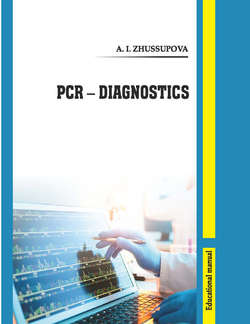PCR – diagnostics

Реклама. ООО «ЛитРес», ИНН: 7719571260.
Оглавление
Aizhan Zhussupova. PCR – diagnostics
FOREWORD
Chapter 1. INVENTION OF THE POLYMERASE CHAIN REACTION
Chapter 2. SIMPLE AND EFFECTIVE: THE PCR PRINCIPLE
Chapter 3. COMPONENTS OF THE PCR
Primers
DNA polymerase
Reaction buffer
Adjuncts and cosolvents
Reaction conditions and experimental protocol
Chapter 4. REAL-TIME PCR AND ITS THERMAL CYCLER SYSTEMS
Chapter 5. REAL-TIME PCR DETECTION AND ANALYSIS
Chapter 6. FLUORESCENT DNA PRIMERS & PROBES IN REAL-TIME PCR
Chapter 7. DESIGN OF PCR PRIMERS AND PROBES
Chapter 8. PCR TEMPLATES
Chapter 9. PCR BIOSAFETY CONSIDERATIONS
Chapter 10. PCR AND CLONING
Chapter 11. PCR MUTAGENESIS
Chapter 12. ANALYSIS OF GENE EXPRESSION
Chapter 13. GENOME ANALYSIS
Chapter 14. PCR IN GMOS DETECTION IN FOOD OR FEED
Chapter 15. PCR IN MEDICINE AND DNA FINGERPRINTING
CLOSING REMARKS
CONTROL QUESTIONS
SAMPLE TASKS
SAMPLE TESTS
Appendix 1. Variations on the basic PCR technique
Appendix 2. PCR primers and probes design software
GLOSSARY
BIBLIOGRAPHY
Отрывок из книги
Before PCR, molecular biologists utilized nucleic acid sequence data (sequence motifs) to design «hybridization» probes for use in assays for the detection and identification of specific RNA and DNA fragments (moieties). These «hybridization» assays were used to determine the presence/absence of specific RNA or DNA sequences within complex mixtures of nucleic acids, via the use of specifically designed (semisynthetic) complementary DNA or RNA molecules (nucleic acid probes) which had been equipped with radioactive labels for detection purposes. The target nucleic acid population was initially attached to a solid carrier phase and then hybridized with specific labeled probe. After stringent hybridization and extensive washing procedures, the presence of the target DNA fragment could be determined by the presence/absence of the radioactively labeled probe on solid carrier phase.
Alternatively, direct visualization of the probe and target molecule was achieved via electron microscopy, with hybridization being quantified on the basis of the different widths of double stranded (hybridized) versus single stranded (non-hybridized) nucleic acids. The most convenient of these hybridization test systems utilized filter hybridization (where the target DNA extract was first immobilized on nitrocellulose or nylon filters), in combination with post-hybridization autoradiography or scintillography. This format greatly increased test sensitivity and vastly improved the technical reliability and speed of the hybridization procedure, allowing the detection of picogram quantities of target material. However, one major disadvantage of these hybridization systems was the requirement for radioactively labeled probes, not least because working with radioactive materials is hazardous for your health, requires legal permits, correct disposal systems, and is relatively expensive to use. For these reasons, radioactive labels have been largely replaced by various (non-radioactive) chemical labels, facilitating the development of colorimetric, chemoluminescent and chemo-fluorescent hybridization detection methods. However, these «second generation)) chemical-labeling and detection systems do not generally yield as high a degree of sensitivity as the original radio-labeling and detection systems, though both systems are amenable to automation and high throughput applications. To date, a variety of elegant techniques based upon the basic hybridization principle have been developed (e.g. sandwich hybridization, Southern- and Northern-blot hybridizations, etc.) and these are frequently applied in both fundamental research and clinical diagnostics. The need to detect very small numbers of clinically relevant molecules was high. For instance, the detection of low-titer viral infections, minimal residual disease in leukemia patients, point mutations in genes or genetic aberrations in tumors etc., all require highly sensitive methodologies. This has led to the development of novel approaches specifically aimed at the amplification of target (gene) sequences prior to detection, such that sensitivity issues related to hybridization/probe detection protocols would no longer be the limiting step of DNA and RNA detection protocols. As with some of the greatest discoveries in science, from penicillin to microwave ovens, PCR was discovered serendipitously. Thanks to the work of many scientists, including Watson and Crick, Kornberg, Khorana, Klenow, Kleppe and Sanger, all the main ingredients for PCR had been described by 1980. Like butter, flour, eggs, and sugar lined up on a kitchen table, the ingredients of PCR were waiting for someone to scream out «Cake!» and open up the scientific community to a technique with a myriad of applications.
.....
Table 3.4
Volumes of additional water to add to each reaction in the magnesium salts
.....